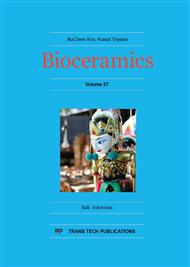[1]
Y Tabata, Biomaterial Design of Culture Substrates for Cell Research, Inflamation and Regeneration 31(2011) 137-145.
Google Scholar
[2]
HI Chang, Y Wang, Cell Responses to Surface and Architecture of Tissue Engineering Scaffolds, in Daniel Eberli (Eds. ), Regenerative Medicine and Tissue Engineering in Cells and Biomaterials, ISBN: 978-953-307-663-8, Available from: http: /www. intechopen. com/books/regenerative-medicine-and-tissue-engineering- cells-and-biomaterials/cell-responses-to-surface-and-architecture-of-tissue-engineering-scaffolds, (2011).
DOI: 10.5772/21983
Google Scholar
[3]
AK Al-Salihi, In vitro evaluation of Malaysian Natural Porites bone graft substitutes (CORAGRAF) for bone tissue engineering: a preliminary study, Braz. J. Oral Sci. 8 (2009) 210-216.
Google Scholar
[4]
R Hou, F Chen, Y Yang, X Cheng, Z Gao, HO Yang, W Wu, T Mao, Comparative study between coral-mesenchymal stem cells-rhBMP-2 composite and auto-bone-graft in rabbit critical-sized cranial defect model, J. Biomed. Mater. Res. A. 80 (2007) 85-93.
DOI: 10.1002/jbm.a.30840
Google Scholar
[5]
SK Nandi, B Kundu, J Mukherje, A Mahato, S Datta, K Balla, Converted marine coral hydroxyapatite implants with growth factors: In vivo bone regeneration, Mater. Sci. Eng. C 49, (2015) 816–823.
DOI: 10.1016/j.msec.2015.01.078
Google Scholar
[6]
G Hu, L Xiao, H Fu, D Bi, H Ma, P Tong, Study on injectable and degradable cement of calcium sulphate and calcium phosphate for bone repair, J. Mater. Sci. Mater. Med 21 (2010) 627-634.
DOI: 10.1007/s10856-009-3885-z
Google Scholar
[7]
AH Dewi, ID Ana, JGC Wolke, JA Jansen, Behavior of plaster of Paris-calcium carbonate composite as bone substitute. A study in rats,J. Biomed. Mater. Res. A, 101 (2013) 2143-2150.
DOI: 10.1002/jbm.a.34513
Google Scholar
[8]
RA Yukna, Clinical evaluation of coralline calcium carbonate as a bone replacement graft material in human periodontal osseous defects, J. Periodontol. 66 (1994) 177-185.
DOI: 10.1902/jop.1994.65.2.177
Google Scholar
[9]
WR Moore, SE Graves, GI Bain, Synthetic bone graft substitutes, ANZ J. Surg. 71 (2001) 354-361.
DOI: 10.1046/j.1440-1622.2001.02128.x
Google Scholar
[10]
H Maeda, V Marquet, T Kasuga, QZ Chen, JA Roether, AR Boccaccini, Vaterite deposition on biodegradable polymer foam scaffolds for inducing bone-like hydroxyl carbonate apatite coatings, J. Mater. Sci. Mater. Med. 18 (2007)2269-2273.
DOI: 10.1007/s10856-007-3108-4
Google Scholar
[11]
T Tuominen, T Jamsa, J Tuukkanen, P Nieminen, TC Lindholm, TS Lindholm, P Jalovaara, Native bovine bone morphogenetic protein improves the potential of biocoral to heal segmental canine ulnar defects, Int. Orthop. 24 ( 2000) 289–294.
DOI: 10.1007/s002640000164
Google Scholar
[12]
E Carletti, A Motta, C Migliaresi, Scaffolds for Tissue Engineering and 3D Cell Culture, Chapter 2nd, in John W. Haycock (eds. ), 3D Cell Culture: Methods and Protocols, Methods in Molecular Biology, 695, Springer Science Business Media, LLC, 2011, pp.17-39.
DOI: 10.1007/978-1-60761-984-0_2
Google Scholar
[13]
F Monchau, P Hivart, B Genestie, Calcite as a bone substitute. Comparison with hydroxyapatite and tricalcium phosphate with regard to the osteoblastic activity, Mat. Sci. Eng. C-Mater 33 (2013) 490-498.
DOI: 10.1016/j.msec.2012.09.019
Google Scholar
[14]
P Wang, L Zhao, J Liu, MD Weir, M Zhou, HHK Xu, Bone tissue engineering via nanostructured calcium phosphate biomaterials and stem cells, Bone Res. 2 (2014)140-147.
DOI: 10.1038/boneres.2014.17
Google Scholar
[15]
OCM Pereira-Junior, SC Rahal, JFL Neto, FCL Alverega, FOB Monteiro, In vitro evaluation of three different biomaterials as scaffolds for canine mesenchymal stem cells, Acta. Cir. Bras. 28 (2013)353-360.
DOI: 10.1590/s0102-86502013000500006
Google Scholar
[16]
J Kurita, M Miyamoto, Y Ishii, J Aoyama, G Takagi, Z Naito, Y Tabata, M Ochi, K. Shimizu , Enhanced vascularization by controlled release of platelet-rich plasma impregnated in biodegradable gelatin hydrogel, Ann. Thorac. Surg. 92 (2011) 837-844.
DOI: 10.1016/j.athoracsur.2011.04.084
Google Scholar
[17]
SANK Anila, Application of Platelets Rich Plasma for regenerative medicine, Trends Biomater. Artif. 20 (2006) 78-83.
Google Scholar
[18]
RE Marx, Platelet-rich plasma (PRP): What is PRP and What is not PRP?, Implant Dent. 10 (2001) 225-228.
DOI: 10.1097/00008505-200110000-00002
Google Scholar
[19]
J Zhang, JHC Wang, Platelet-Rich Plasma releasate promotes differentiation of tendon stem cells into active tenocytes, Am. J. Sports. Med. 38 (2010) 2477-2486.
DOI: 10.1177/0363546510376750
Google Scholar
[20]
E Barry, EW Jennifer, BSH Joel, Platelet quantification and growth factor analysis from Platelet-Rich Plasma: implications for wound healing, PRS 114 (2004) 1502-1508.
DOI: 10.1097/01.prs.0000138251.07040.51
Google Scholar
[21]
S Huang, Z Wang, Influence of platelet-rich plasma on proliferation and osteogenic differentiation of skeletal muscle satellite cells: An in vitro study, Oral Surg. Oral Med. Oral Pathol. Oral Radiol. Endod. 110 ( 2010) 453-462.
DOI: 10.1016/j.tripleo.2010.02.009
Google Scholar


